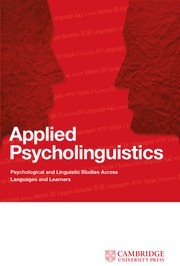Crossref Citations
This article has been cited by the following publications. This list is generated based on data provided by
Crossref.
Boscolo, Brian
Ratner, Nan Bernstein
and
Rescorla, Leslie
2002.
Fluency of School-Aged Children With a History of Specific Expressive Language Impairment.
American Journal of Speech-Language Pathology,
Vol. 11,
Issue. 1,
p.
41.
Williams, A. Lynn
and
Elbert, Mary
2003.
A Prospective Longitudinal Study of Phonological Development in Late Talkers.
Language, Speech, and Hearing Services in Schools,
Vol. 34,
Issue. 2,
p.
138.
Buiza Navarrete, J.J.
Adrián Torres, J.A.
González Sánchez, M.
and
Rodríguez-Parra, M.J.
2004.
Evaluación de marcadores psicolingüísticos en el diagnóstico de niños con trastorno específico del lenguaje.
Revista de Logopedia, Foniatría y Audiología,
Vol. 24,
Issue. 4,
p.
142.
Grigorenko, Elena L.
and
O'Keefe, Paul A.
2005.
Cognitive Developmental Change.
p.
318.
SMITH, BRUCE L.
MCGREGOR, KARLA K.
and
DEMILLE, DARCIE
2006.
Phonological development in lexically precocious 2-year-olds.
Applied Psycholinguistics,
Vol. 27,
Issue. 3,
p.
355.
Moeller, Mary Pat
Hoover, Brenda
Putman, Coille
Arbataitis, Katie
Bohnenkamp, Greta
Peterson, Barbara
Lewis, Dawna
Estee, Sandy
Pittman, Andrea
and
Stelmachowicz, Pat
2007.
Vocalizations of Infants with Hearing Loss Compared with Infants with Normal Hearing: Part II – Transition to Words.
Ear & Hearing,
Vol. 28,
Issue. 5,
p.
628.
Tsybina, Irina
and
Eriks-Brophy, Alice
2007.
Issues in Research on Children With Early Language Delay.
Contemporary Issues in Communication Science and Disorders,
Vol. 34,
Issue. Fall,
p.
118.
Moeller, Mary Pat
Hoover, Brenda
Putman, Coille
Arbataitis, Katie
Bohnenkamp, Greta
Peterson, Barbara
Wood, Sharon
Lewis, Dawna
Pittman, Andrea
and
Stelmachowicz, Pat
2007.
Vocalizations of Infants with Hearing Loss Compared with Infants with Normal Hearing: Part I – Phonetic Development.
Ear & Hearing,
Vol. 28,
Issue. 5,
p.
605.
Fasolo, Mirco
Majorano, Marinella
and
D'Odorico, Laura
2008.
Babbling and first words in children with slow expressive development.
Clinical Linguistics & Phonetics,
Vol. 22,
Issue. 2,
p.
83.
Blount, R. L.
Simons, L. E.
Devine, K. A.
Jaaniste, T.
Cohen, L. L.
Chambers, C. T.
and
Hayutin, L. G.
2008.
Evidence-based Assessment of Coping and Stress in Pediatric Psychology.
Journal of Pediatric Psychology,
Vol. 33,
Issue. 9,
p.
1021.
KEREN-PORTNOY, TAMAR
MAJORANO, MARINELLA
and
VIHMAN, MARILYN M.
2009.
From phonetics to phonology: The emergence of first words in Italian*.
Journal of Child Language,
Vol. 36,
Issue. 2,
p.
235.
Morris, Sherrill R.
2009.
Test–Retest Reliability of Independent Measures of Phonology in the Assessment of Toddlers' Speech.
Language, Speech, and Hearing Services in Schools,
Vol. 40,
Issue. 1,
p.
46.
Roulstone, Sue
Miller, Laura L.
Wren, Yvonne
and
Peters, Tim J.
2009.
The natural history of speech impairment of 8-year-old children in the Avon Longitudinal Study of Parents and Children: Error rates at 2 and 5 years.
International Journal of Speech-Language Pathology,
Vol. 11,
Issue. 5,
p.
381.
Lambrecht Smith, Susan
Roberts, Jenny A.
Locke, John L.
and
Tozer, Rebekah
2010.
An Exploratory Study of the Development of Early Syllable Structure in Reading-Impaired Children.
Journal of Learning Disabilities,
Vol. 43,
Issue. 4,
p.
294.
Ball, Martin J.
Müller, Nicole
Klopfenstein, Marie
and
Rutter, Ben
2010.
My Client Is Using Non-English Sounds! A Tutorial in Advanced Phonetic Transcription Part II: Vowels and Diacritics.
Contemporary Issues in Communication Science and Disorders,
Vol. 37,
Issue. Fall,
p.
103.
Morris, Sherrill R.
2010.
Clinical Application of the Mean Babbling Level and Syllable Structure Level.
Language, Speech, and Hearing Services in Schools,
Vol. 41,
Issue. 2,
p.
223.
2011.
The Acquisition of German.
p.
350.
Zanobini, Mirella
Viterbori, Paola
and
Saraceno, Francesca
2012.
Phonology and Language Development in Italian Children: An Analysis of Production and Accuracy.
Journal of Speech, Language, and Hearing Research,
Vol. 55,
Issue. 1,
p.
16.
Chiat, Shula
and
Roy, Penny
2013.
Early Predictors of Language and Social Communication Impairments at Ages 9–11 Years: A Follow-Up Study of Early-Referred Children.
Journal of Speech, Language, and Hearing Research,
Vol. 56,
Issue. 6,
p.
1824.
Blom, Elma
Vasić, Nada
and
de Jong, Jan
2014.
Production and Processing of Subject–Verb Agreement in Monolingual Dutch Children With Specific Language Impairment.
Journal of Speech, Language, and Hearing Research,
Vol. 57,
Issue. 3,
p.
952.

